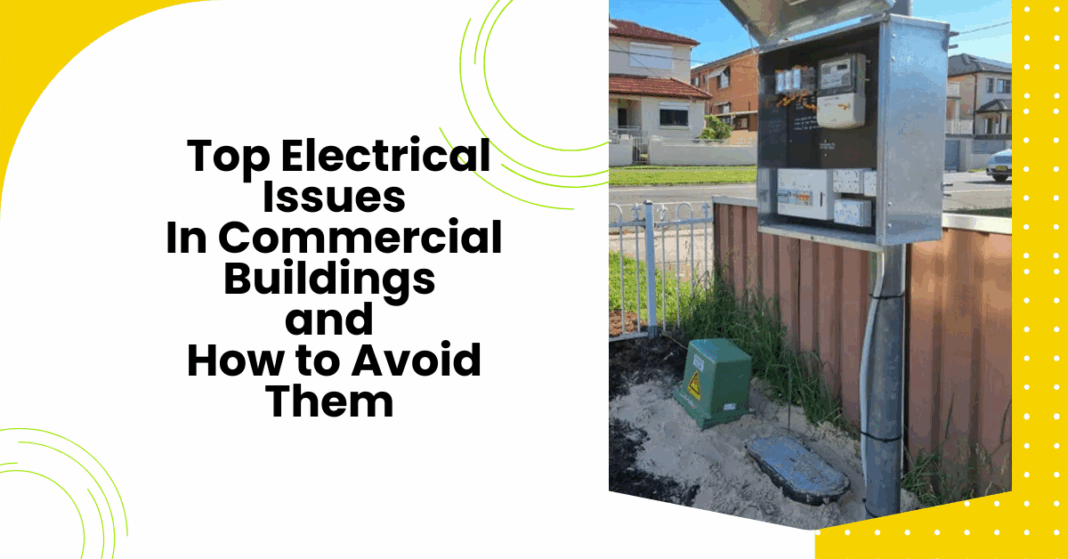In commercial buildings, electrical problems usually start small. A flickering light. A tripped breaker. A burnt-out socket. But left unchecked, they turn into the kind of issues that shut down floors, damage equipment, and put people at risk.
This isn’t about panic. It’s about staying ahead of what’s common, what’s preventable, and knowing when it’s time to get someone in before things go south. Below are the usual suspects when it comes to electrical faults in commercial properties, and what you can do to stop them from creeping in.
1. Tripped Circuit Breakers That Keep Coming Back
It’s very normal for a circuit breaker to trip now and then. That’s what it’s designed to do. But if it keeps happening, something’s not right.
You might have:
- Too many appliances pulling power from the same circuit
- Faulty equipment
- Worn-out wires behind the walls
- Or a short circuit somewhere in the system
What helps?
Get someone to check your power load. Often, things just need to be split across more circuits, or a switchboard needs an upgrade.
2. Lights That Flicker, Buzz, or Burn Out Too Fast
If your lights are blinking constantly, or we can say doing the disco thing, don’t ignore it. These are some of the common signs you need to get it fixed. Buzzing or flickering can mean loose wires, bad fittings, or loose connections. It might even be a sign that the voltage is jumping around more than it should.
What to do:
Swapping out bulbs might fix it temporarily, but if it keeps happening, have the wiring checked. Old ballasts, poor-quality fixtures, or unstable current can quietly wear down your entire lighting setup. You also need to keep in mind the wiring.
3. Outdated Wiring That’s Not Up to the Job
Some older buildings still rely on electrical systems from decades ago. That was fine when there were a few computers and a printer in the corner. But with modern offices running heavy tech, air conditioning, fridges, signage, and more, that old wiring starts to struggle.
Signs you’ve got outdated wiring:
- Switches feel warm
- You notice a faint burning smell
- The lights dim when big appliances are turned on
- Plugs spark when you use them
Best approach?
If your wiring is 20+ years old, get it inspected. It’s not just about performance. It may even cause a power surge. It’s about avoiding fires and costly breakdowns that shut your building down.
4. Power Surges That Damage Equipment
Even small, quick surges can damage sensitive gear. And in an office or commercial space, that means computers, monitors, phones, servers, security systems, all at risk.
What causes surges?
- Faulty appliances
- Poor grounding
- Short circuits
Prevention tip:
To begin with, you can use surge protectors. Also, make sure to keep high-draw machinery on separate circuits. And if you notice appliances acting weird after a surge, don’t just plug them back in; the appliances or the outlets might’ve taken a hit.
5. Dodgy Switches and Loose Outlets
Loose wall sockets and switches that feel ‘soft’ when you press them can point to loose wiring inside the wall. That’s where arcing happens, when electricity jumps from one contact to another. That’s also where fires start.
What to do:
If switches are causing issues, or they crackle easily, if outlets are not steady at all, or if plugging something in feels like it takes effort, stop using them. Call a level 2 electrician to replace the fitting and check the wiring behind.
6. Overused Power Boards and Extension Cords
This one’s common in offices. You run out of outlets, so someone brings in a power board. Then another. Before long, you’ve got cords running under desks and behind cabinets like spaghetti.
The risk?
Too much current on a single board overheats the plastic, damages plugs, and can short the whole system.
Fix it before it’s a problem:
Get additional outlets installed where they’re needed most. Don’t daisy-chain boards together. And if you notice black marks on plugs or boards feeling hot, bin them immediately.
7. Skipping Regular Maintenance
This is the big one. Most serious electrical faults don’t just appear out of nowhere. They build up slowly. And without a maintenance plan in place, you’ll only know about them when something breaks, or worse.
Why regular checks matter:
- They catch small problems before they get expensive
- They keep your insurance valid
- They reduce downtime
- They keep staff and visitors safe
Have a licensed electrician walk through your building every few months. Even just tightening loose screws on breakers and checking load balance can make a huge difference.
8. When You Need an Emergency Electrician
Sometimes, it’s not about prevention. It’s about acting fast. If you ever smell something burning, see smoke, or feel a shock when touching an appliance, call an emergency electrician immediately. Don’t wait. Don’t try to fix it yourself. Turn off the power if it’s safe to do so, then get out and make the call.
Final Word
Every commercial building, whether it’s a small office or a multi-storey complex, has its quirks. But electrical problems tend to follow the same patterns. If you can stay ahead of them, you avoid the breakdowns, protect your gear, and keep everyone safe.
And whether your building’s in Sydney or anywhere else, a bit of planning now can save you from major disruption down the line. Check your systems, educate your team, and bring in the pros when needed. It’s not just good building management, it’s common sense.



